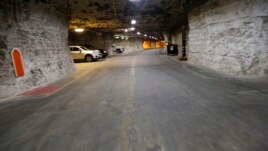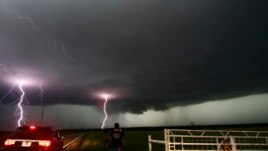18 August, 2013
Hello, and welcome to the Monday edition of As It Is, our daily show for people learning everyday American English.
I'm Christopher Cruise in Washington.
Today on the program, we talk with a scientist who is working to help weather experts improve their tornado predictions.
"I'm seeing it through computers and through the radar screens, which are making three-dimensional images of the wind and the debris and the hail, flowing around the storm."
And we'll take you back to the day in 1812 when a famous American ship got its nickname...
But first, we tell you about a disputed project to build a large survival shelter in case disaster strikes the United States...
The World's Biggest Private Survival Shelter?
For many years, the United States government has kept underground shelters for the president and other top officials in case of a major disaster or attack. But ordinary citizens do not have such a place to go to -- unless, of course, they build their own.
One man has decided to do just that, but not only for himself. He is building a huge underground shelter that will hold thousands of people. Not everyone thinks that's a good idea.
The VOA's Mike Richman recently spoke with the man -- as well as his critics.
Robert Vicino thinks humans are living in what is sometimes called "the end times." He believes that a natural or manmade disaster will soon make life on the surface of the Earth impossible.
His company -- called "Vivos" -- is building what it says is the world's largest private underground survival shelter.

This artist rendering released by Vivos, an underground shelter network, shows a design for an underground bunker.
"Somehow, I had this inspiration that I needed to build a shelter deep underground for as many as 5,000 people for what is coming our way. And the key word there is ‘coming,' and the question is ‘from where and what?' I didn't know the answer. I still don't."

Paved roadways lead the way to the Vivos Shelter and Resort during a tour of the facility in Atchison, Kansas, June 18, 2013.
Only people who pay the one-time cost of $20,000 can use it. Anyone in the world can join.
Paul Seyfried is an adviser to a group called the American Civil Defense Association. It tries to prepare the public for manmade and natural disasters. Mr. Seyfried wonders if the Vivos shelter could operate if a disaster hits.
"My only reservation I would have is who is going to be in charge of law enforcement and then when you put 1,500 or 1,600 people together from all these different backgrounds with varying amounts of food and other support -- I'm just trying to get my mind around all the problems they're going to have with that."
Jacque Pregont is president of the Atchison Chamber of Commerce, a business group. The organization hopes the shelter will bring in travelers who will spend money and improve the town's economy -- disaster or not.
"I would hope that they are going to end up coming here and spending some time here and not just waiting for a catastrophic event."
I'm Mike Richman.
Getting Close to Tornadoes
Weather experts are able to predict bad weather better than ever before thanks to satellites, high-altitude balloons and radar stations. But for many years these experts have incorrectly predicted tornado formation, giving false warnings about 75 percent of the time.
So, scientists are working to improve their tornado predictions. They are getting close to the large and dangerous wind storms to see how they form.

Doppler on Wheels 7 samples a severe thunderstorm in western Nebraska. (Photo by Tim Marshall, 2010)
"I'm seeing it through the computers and through the radar screens, which are making three-dimensional images of the wind and the debris and the rain and hail flowing around the storm."

Cloud to ground lightning strikes near storm chasers during a tornadic thunderstorm in Cushing May 31, 2013.
Information gathered by the instruments could help builders design stronger homes in areas where such dangerous storms are common.
Scientists are learning more about which storms develop into tornados by studying them from start to end. Mr. Wurman says that radar information has taught them that a "wind surge" could be what causes a storm to turn into a tornado.
"The scientific process is that we need to now observe that and repeat that observation in maybe a dozen or more other thunderstorms, and in maybe a dozen or more thunderstorms that aren't making tornados, to really see if that surge causes tornados and if there is no surge, whether there is no tornado. "